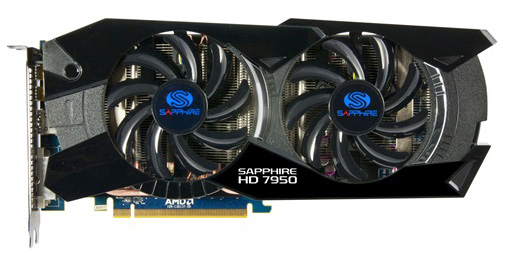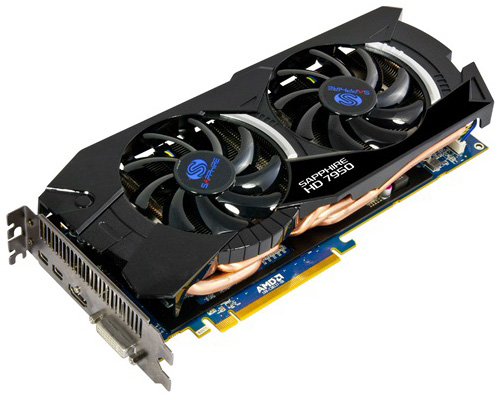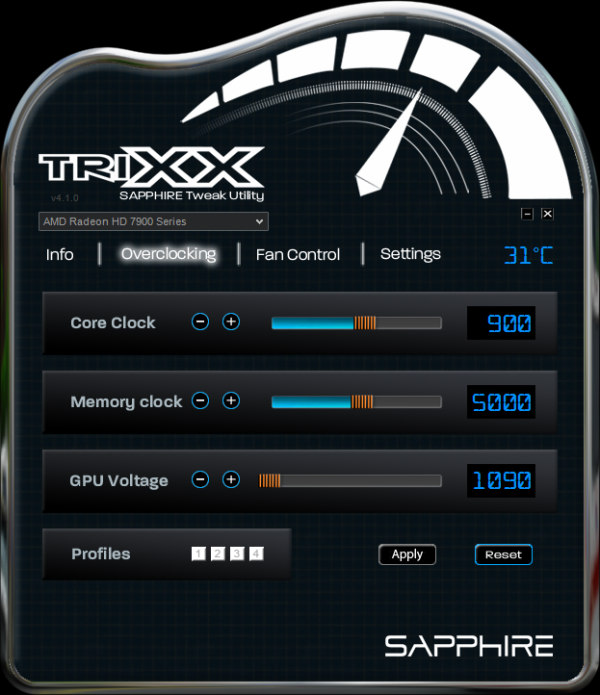AMD Radeon HD 7950 Review Feat. Sapphire & XFX: Sewing Up The High-End Market
by Ryan Smith on January 31, 2012 9:02 AM ESTMeet the Sapphire HD 7950 Overclock Edition
Since our reference 7950s are built on the 7970 PCB and cooler, we’re going to jump right into our vendor cards starting with the Sapphire HD 7950 Overclock Edition.
As with all of the 7950 cards launching today, Sapphire’s HD 7950 Overclock Edition uses the AMD 7950 PCB. This is a slightly shorter PCB measuring 10.25” long, saving .25” over the 7970 PCB by eliminating a few components that the lower board power of the 7950 makes unnecessary. The PCB is otherwise very similar to the 7970 PCB, utilizing 12 GDDR5 memory chips organized around the Tahiti GPU, while at the top you’ll find the 2 CrossFire connectors, a pair of 6pin PCIe power sockets, and the BIOS selection switch. The latter will be of particular interest to unlockers, as the switch should make it possible to safely attempt to unlock the 7950 into a 7970.

Moving on, as this is a semi-custom card the real differentiation is in the factory overclock and the cooler. On the performance side of things Sapphire will be shipping the 7950 Overclock Edition at 900MHz core and 5GHz memory, representing a 100MHz (12.5%) core overclock and no change on the memory clock.
Meanwhile for the cooler Sapphire is using what they’re calling the Dual-X cooler. The Dual-X is yet another double-wide dual-fan open air cooler, with 2 fans providing copious airflow over an aluminum heatsink running virtually the entire length of the card. Sapphire’s fan cutouts are just a bit bigger than most other dual-fan coolers and placed a bit higher, and as a result the Dual-X cooler is a bit taller than the PCB by about 15mm at its highest point. Meanwhile the cooler is also a fair bit longer than the PCB, putting the total card length at 11”.
Moving below the fans and the heatsink we’ll find the heatpipe assembly, which is responsible for carrying heat from the GPU to the heatsink. The Dual-X uses 5 copper heatpipes of varying radius that run from one end of the heatsink to the other. The 5 heatpipes converge at the base of the assembly, where a copper baseplate provides contact with the GPU. Meanwhile cooling for the VRM MOSFETs and RAM is provided by a black aluminum plate, which is placed over those components with heat transfer provided by the use of thermal pads. There is no connection between the plate and the heatsink, so the only heat dissipation from the plate is provided by whatever airflow from the fans reaches the plate.

At the front of the card we’ll find the display ports, which as this is an AMD PCB the card utilizes the standard AMD 7000 series port configuration of 1 DL-DVI port, 1 HDMI port, and 2 mini-DisplayPorts. Filling out the second slot is the grating for ventilation, though even with the ventilation slot the usual precautions for an open-air cooler apply: you’ll need a case with enough airflow to handle the roughly 200W of heat the card is capable of dumping inside of your case.
Rounding out the package is the usual collection of dongles and materials. Sapphire includes 2 molex-to-6pin PCIe adaptors, an HDMI to DVI dongle, a miniDP to DisplayPort dongle, a DVI to VGA dongle, and a 1.8m HDMI cable. Along with the dongles Sapphire packs a quick start guide and a driver installation CD.
The only thing you won’t find packed in the box is TriXX, Sapphire’s in-house overclocking utility. TriXX has been around since the 6900 series, but as this is the first high-end Sapphire card we’ve reviewed since it was released, this is the first time we’ve had it available for a review.
Fundamentally TriXX is a fairly well designed, albeit barebones overclocking utility. Along with an info readout similar to GPU-Z, TriXX provides overclocking and fan control support for Sapphire’s cards, including support for custom fan profiles and more importantly voltage control. With TriXX it’s possible to overvolt most of Sapphire’s performance and high-end cards, and as Sapphire uses AMD reference PCBs it also works with any other cards using AMD’s PCBs.
Beyond these features there’s little more to TriXX. It’s not an all-encompassing video card utility like MSI’s Afterburner, which means it comes up short if you need more functionality but it's exactly what you need if you just want to overclock. To that end it’s a clear step up compared to most other manufacturer’s poorly designed utilities, and from a design perspective its only real sin is the hard to read blue-on-black text. Otherwise it’s a competent overclocking utility that does exactly what it’s supposed to and provides voltage control for those who need it.
Finally, Sapphire will be selling the 7950 OE for $479, $30 over the baseline 7950 MSRP. Meanwhile the warranty on their card is their standard 2 year warranty.















259 Comments
View All Comments
chizow - Sunday, February 5, 2012 - link
Typical, resort to histrionics instead of facts and reasoning when arguing.Like I said, the value in the mid-range is there every single generation, not just with the 8800GT. There's a reason why AnandTech and many other sites proclaimed that launch "The Only Card that Matters" and since then any similar card that offers that same price:performance metric relative to the high end is affectionately referred to as "the next 8800GT" like the GTX 460/560 etc.
Galidou - Sunday, February 5, 2012 - link
Still you won't take any arguments that will justify paying triple the price of a card for not even double the performance, or paying more for a card that offer less performance than a last gen x2 card NEVER.That gtx280 was really mispriced and Nvidia took people for dummies by pricing it so high for the performance you gained. The most performance you saw out of those was due to the first over 1gb memory in high resolution like 2560 which applied to not even .5% of the gaming population back then
I don'T care about the titles, titles mean nothing to me that ''only card that matters'' doesn'T change the fact that paying triple the price for a video card for not even double the performance is tanking people for dummies.
Galidou - Sunday, February 5, 2012 - link
We should be happy that Ati doesn't use such pricing technique because it competes against last gen refreshed video cards and justify to pay a higher % price than the % of performance you gain.chizow - Sunday, February 5, 2012 - link
Yeah they use far worst, at least this time.They offer linear scaling of price and performance instead of offering better performance at the same prices which you would expect from a next-gen chip.
chizow - Sunday, February 5, 2012 - link
Why would I take any of your arguments when they are CLEARLY flawed.Its funny why don't you try using those arguments to justify the 7970's pricing? LMAO. Triple? Its not even DOUBLE the performance of previous mid-range cards.
Or previous x2 cards? The 7970 isn't even in the same discussion as the 6990 or GTX 590.
And of course, we've already covered how it falls completely short with regard to previous generation single-GPU flagship cards. Yet AMD somehow thinks it was worth a 10% increase in prices, something not even Nvidia has done since the 8800GTX.
What's REALLY funny though is how you seem to think the GTX 280 was priced for dummies given it actually meets the standards for next-gen GPUs and deserved its price, yet see NOTHING wrong at all with the pricing of the 7970.
Now what does that say about you and those defending it??? :(
Galidou - Sunday, February 5, 2012 - link
It's not double the performance but not double the price either still 7950 performance of gtx580 for cheaper price, convinces me enough to say it isn't taking people for dummies...chizow - Sunday, February 5, 2012 - link
Yeah once again, selective application of flawed logic.Like I said, Tahiti meets none of the established standards you'd expect from a flagship part while the GTX 280.
Yet you think the GTX 280 was priced for dummies and the 7970/7950's pricing is perfectly justified?
Honestly that just makes you look dishonest.
Or the exact type of customer AMD is looking to entice maybe! :D
Galidou - Sunday, February 5, 2012 - link
LOL I'm not even looking at changing video card but I can say bad things about ATI but you'Re definitely 1: a hardcore Nvidia fanboy or 2: they pay you to say things about standard justifying stupid prices... lol standard, what an argument, next tie I'll buy a video card, I'll try to forget a little about perfromance and look at the standard...chizow - Sunday, February 5, 2012 - link
and galidou goes off the deepend folks.Galidou - Sunday, February 5, 2012 - link
mets the standard, now chizow is our standard expert, point is I look at numbers, not standard, triple the price not double the performance, I don'T care abbout the standard when I game with it on my computer.Oh wait my game stopped playing, it tells me, this video card doesn'T meet the standard for it'S price... OMG I should of cared more....